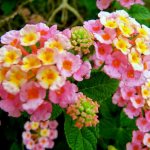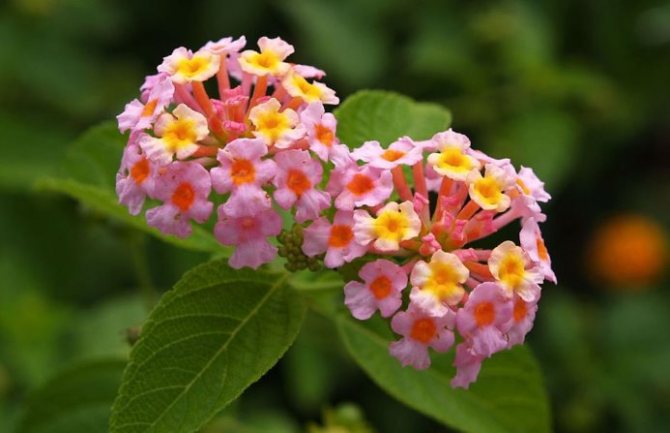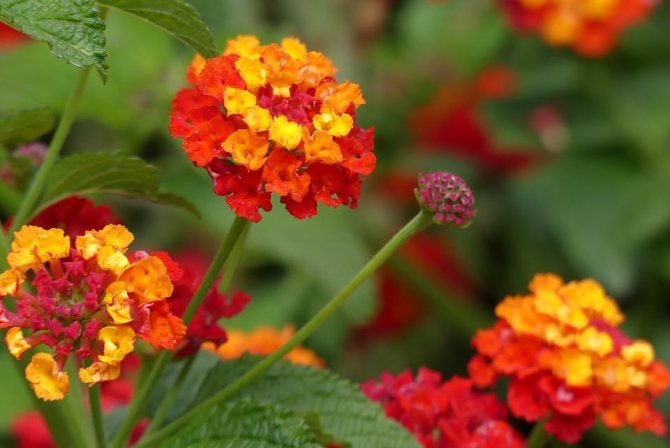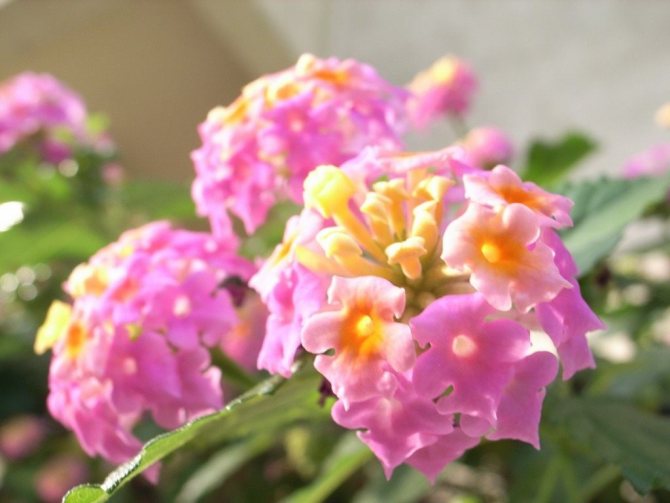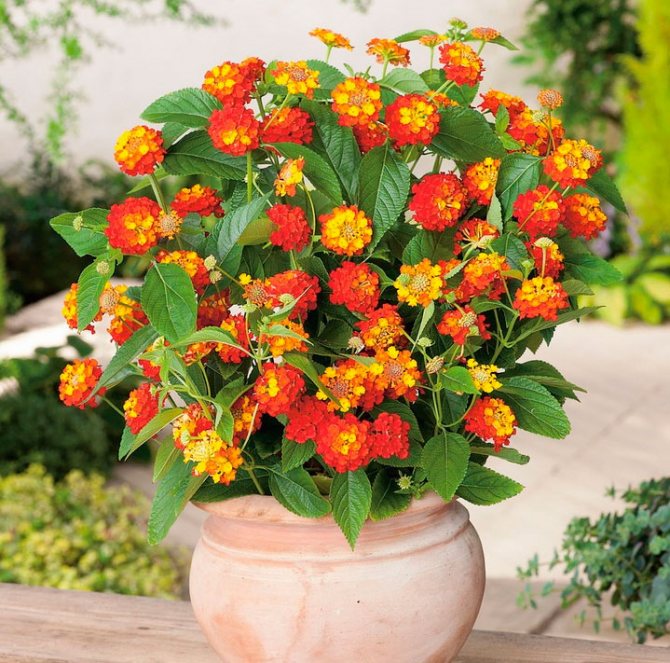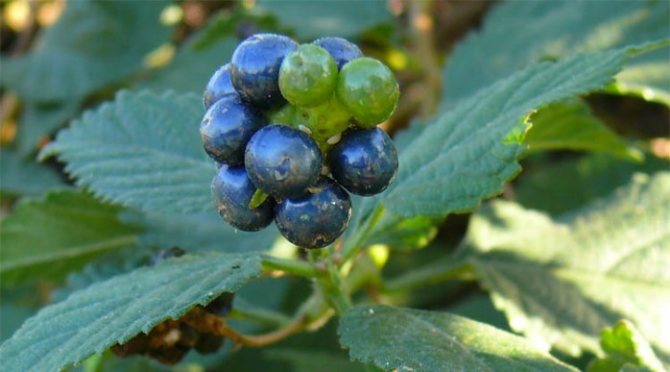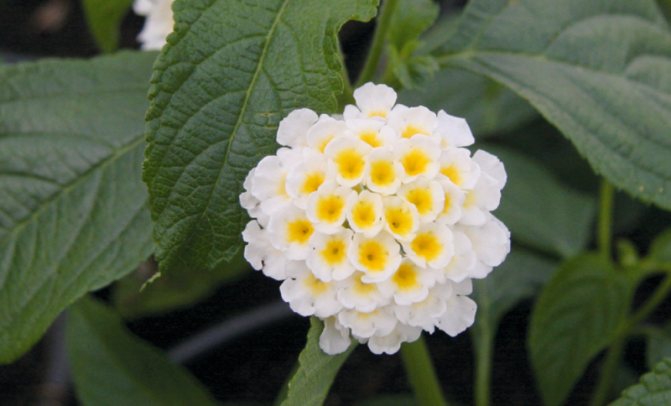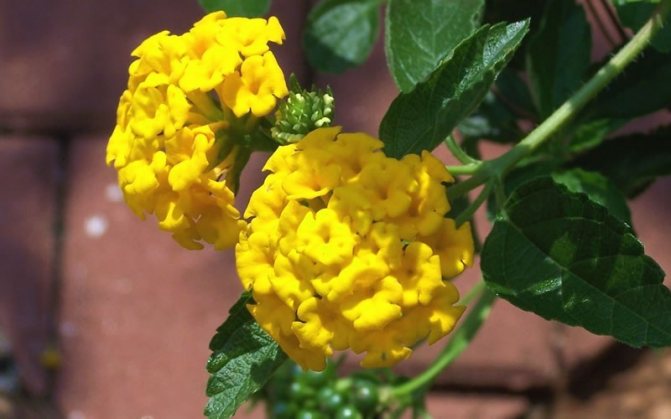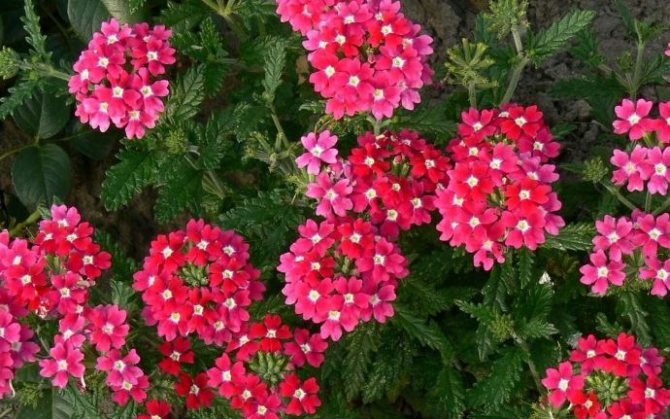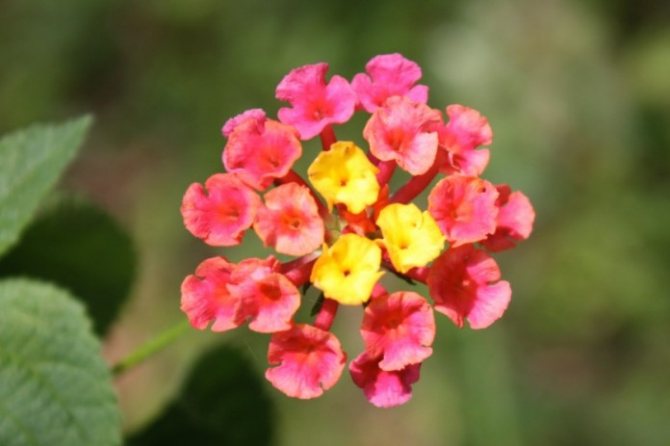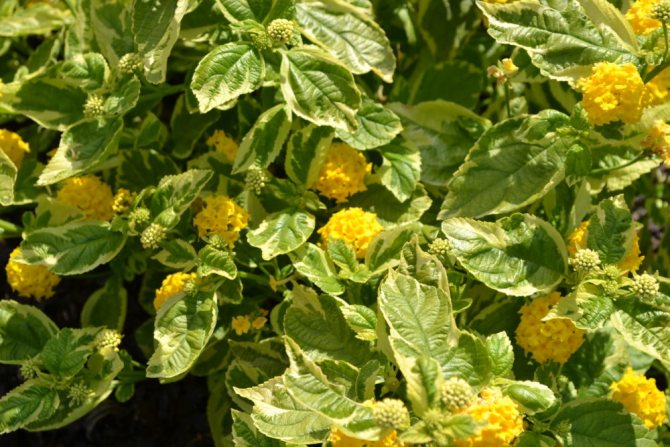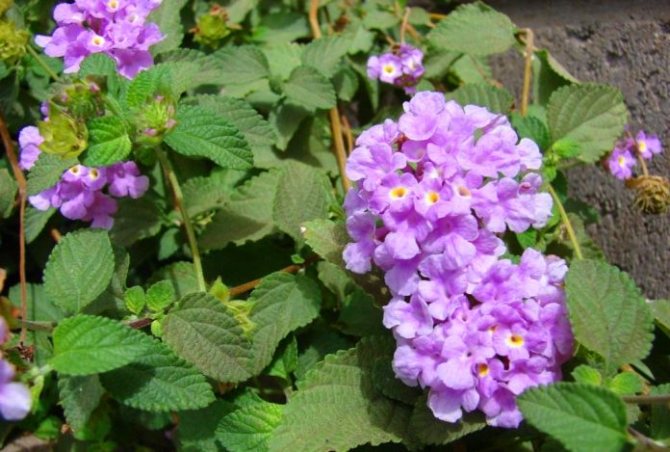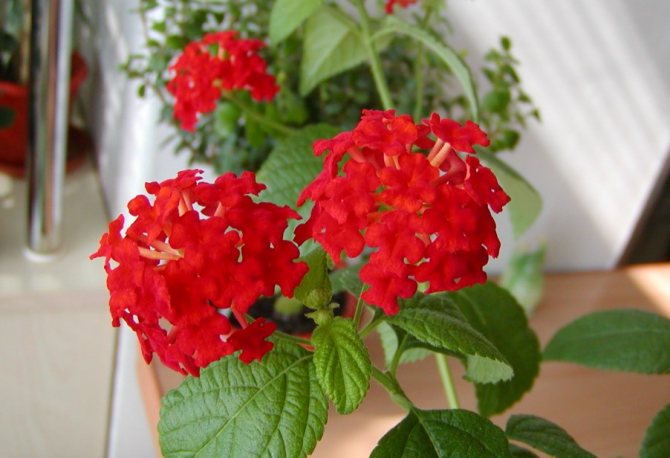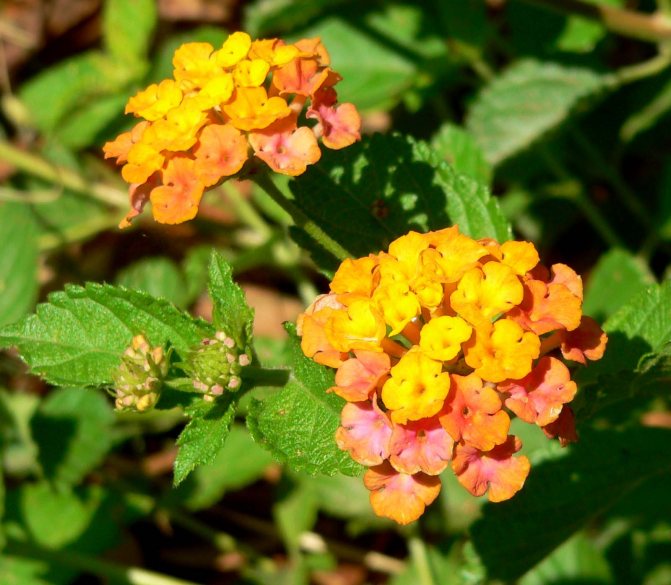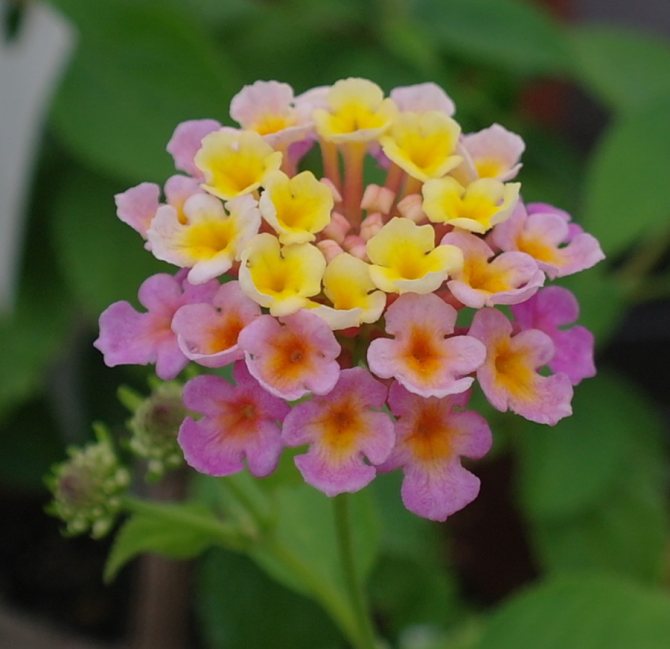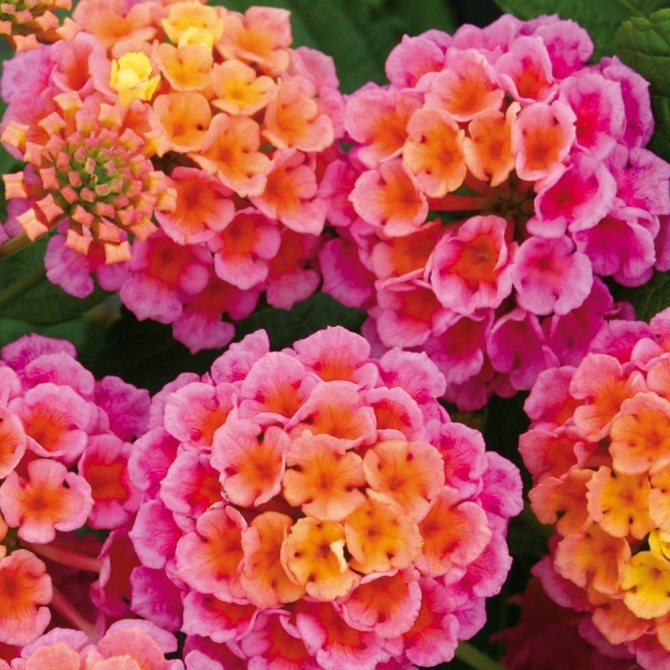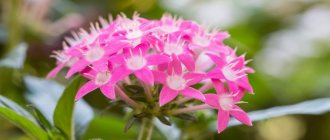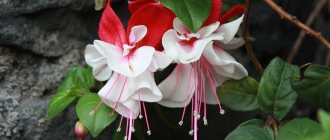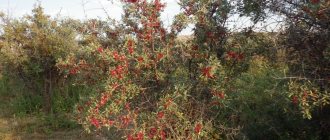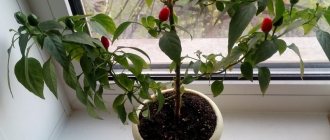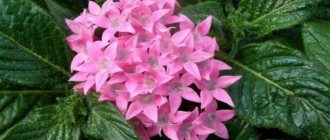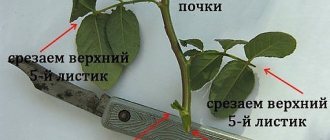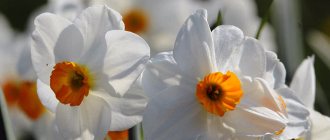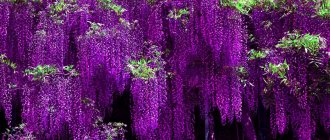And the flower is unusual.
Gardeners in many countries admire him. The plant blooms for a long time, changing color from white and pink to rich yellow and even purple flowers. You touch its leaves, and a delicious aroma will spread around.
This unusual flower came to us from the rainforests of Bolivia, Colombia, Mexico. But thanks to its unpretentiousness, the plant has spread throughout the world.
Lantana is a perennial shrub up to 2 m high, a representative of the Verbenov family. It blooms all summer until September, throwing out long peduncles with balls of flowers on the shoots of the current year. One blooms for about three days.
In one inflorescence at the same time you can see flowers with multi-colored petals. Has dark blue drupe fruits.
At home it grows very quickly, it is considered a weed, even prohibited by law in Australia, South Africa. Unripe fruits are dangerous to animals and humans. Lantana has medicinal properties, is used for rheumatism, malaria, dermatitis, snake bites. Well repels insects: mosquitoes, flies.
There are about 130 known varieties. Two varieties are grown as a houseplant.
French breeders have developed new single-color varieties. There are ampelous varieties with creeping shoots like 'Goldsonne'.
Gardeners are very fond of sterile, abundantly flowering, but not fruitful, varieties and dwarf varieties.
Description of Lantana
Unfortunately, Lantana is a very capricious plant, which is why it has got one very nasty character trait. The fact is that Lantana does not know how to get along with other plants at all. Moreover, being planted next to them, it completely suppresses them and becomes their destruction. Therefore, it is very rarely planted in open ground, and if it is planted, it is exclusively on a very well-arranged and specially designated garden bed for Lantana. By the way, in India, for this unpleasant feature of Lantana, this flower was nicknamed "the curse of the planter." However, given this, it is not surprising that you can very rarely meet her in the garden, although not impossible. So we highly recommend that you grow this flower in a pot.
If we talk about the species and varieties that are best grown and are more suitable for young, inept florists than others, then you should pay attention to Lantana Camara. It is also called Lantana prickly. This species, by the way, has a huge variety of hybrids, and therefore, whatever your preferences, you will definitely find at least one that you like. Having met such a flower in the wild, you might think that it is not very suitable for home growing. In the end, Lantana Camara reaches a height of up to one and a half meters. However, this impression is deceptive, because at home it will not be so bulky and will not grow more than half a meter. In addition, its width is greatly reduced, making Lantana Camara a very compact flower.
However, of course, Lantana is not popular for its stunning compactness. She became famous for her stunningly vibrant flowers that many other plants can only envy. In addition, they, like the plant itself, have their own little zest: during flowering, Lantana flowers constantly change their color.At the same time, they do this far more than once. The inflorescences bloom yellow. However, if you do not like this color due to the fact that, for example, it is too bright, you can just wait a while and you will see the miracle of transformation. The flowers will become one-time, and towards the end of the flowering period they will completely turn into a scarlet-red hue.
Speaking of shoots, they have a tetrahedral shape. Moreover, they are quite elongated and long. It is also worth remembering that within a few weeks after germination, these shoots are covered with small, but very sharp thorns. Therefore, any work on transplanting Lantana must be carried out with relatively thick gloves. However, for those who don't like thorny plants, there is a softer garden form of Lantana with smooth shoots. However, in addition to softness, the stems of this species also have a weakness: they are very delicate and fragile and constantly hang down like willow branches. Therefore, this flower will be best kept in a hanging pot or in a special container.
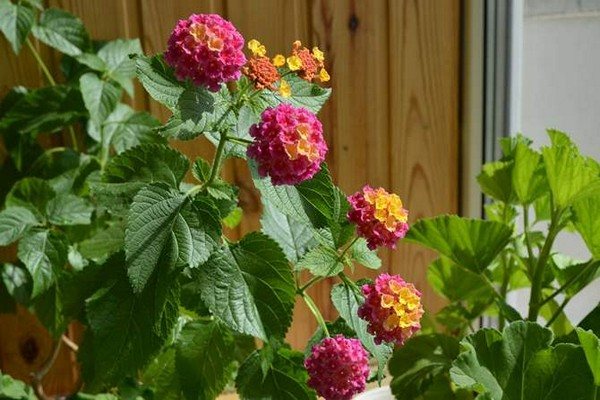
However, since the vast majority grows Lantana far from gardening, but at home, it is worth talking about how to do it right. In fact, this is done without any major difficulty. The only major problem you could theoretically face is Lantana's growing too fast. However, in order for it not to grow uncontrollably, it is enough just to cut off too long shoots that go beyond the limits of the pot in time. In addition, it will allow the flower to donate less nutrients to shoot development and focus on the flowers.
A huge plus of this small evergreen shrub is that it blooms absolutely all summer, which means that you definitely don't have to worry about not having time to enjoy the beauty of its inflorescences. But in the fall, it is better not to disturb the plant, because then it begins a dormant period, which does not stop until the next spring begins. By the way, if you grow Lantana in a pot, then we have one more very useful advice for you: if the sun is shining on the street and no cold snaps are expected in the near future, then it is quite possible to take the flower outside. This will provide him with the closest to natural conditions.
Another highlight of Lantana is that after the end of the flowering period, small juicy black berries appear on its peduncles, which look pretty cute and continue to delight the eye even after the flowers stop doing it. However, you should not succumb to the temptation, and even more so, allow children and pets to do this, because the fruits of Lantana are very poisonous. However, the berries can be cut off. In this case, there is a great chance that another inflorescence will form at the cut site, if the plant, of course, has not yet gone into dormancy.
If you decide to grow Lantana in the garden, then you will need to find a good, suitable place for it. And the most suitable place for Lantana would be the most lit and least populated with other flowers. We have already described the reasons for this above, however, we recall that Lantana gets along very badly with other plants, or, more precisely, does not allow them to grow and develop normally.
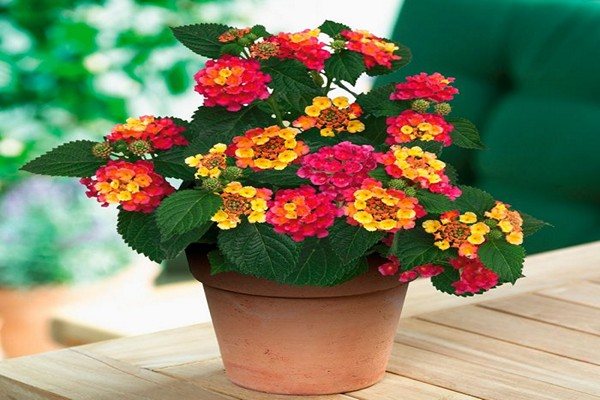

Features of the
Features The description of the genus Lantana (Lantana), which received its name thanks to the Swedish naturalist Karl Linnaeus, comes down to a systematic classification. This perennial belongs to the Verbenaceae family. Wild species, and there are many of them at the moment (from 140-170), mainly grow in the territories of Central and South America, and for some species the habitat is Africa and Southeast Asia.
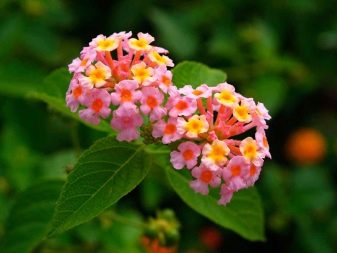

Its flexible, fast-growing stems with a compacted upper layer are light green in color; in some species, thorns are present on the surface of the shoots. Short-petiolized leaves with a predominantly green color are located on the stems opposite each other or in a spiral order. The leaf blade is small (4–5 cm), predominantly oval in shape with a serrated edge and clearly defined veins, very similar in appearance to a nettle leaf. In most species, the leaves are tough, with a rough surface to the touch, but there are varieties with smooth leaves.
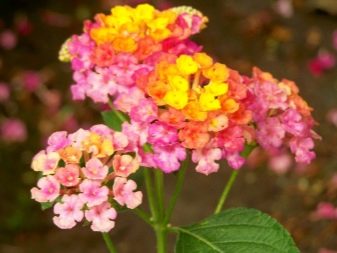

The plant has a rather long and beautiful flowering. The flowers are small, the corolla diameter does not exceed, as a rule, 4–5 cm, collected in inflorescences. In wild-growing forms, in one inflorescence, flowers with different colors of petals can be observed. White, yellow, orange and scarlet flowers on their thin pedicels are quite tightly adjacent to each other, forming a very beautiful multi-colored ball. The variety in the color of the petals is associated with the degree of maturity of each flower: the more time passes from the day the bud is dissolved, the darker the petals acquire.
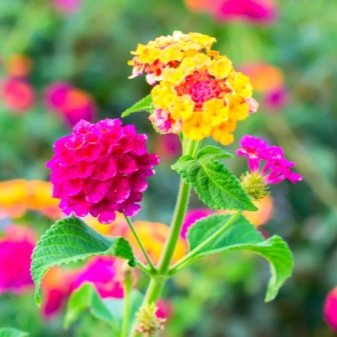

Lantana is famous not only for its color-changing petals, but also for the specific aroma emanating from the leaves of the plant. From the slightest contact, the glands located on the surface of the leaf plate are triggered, and the surrounding space is immediately filled with a spicy aroma. Not everyone will like this aroma, because in addition to the pleasant notes of lemon and mint, it also contains the smell of camphor and the subtle aroma of onions.
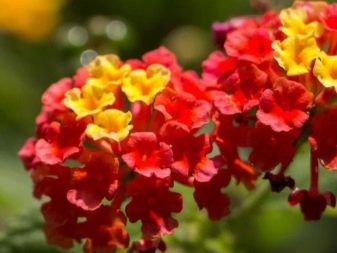

How to care for Lantana?
Of course, Lantana is far from the most whimsical plant to care for. However, it is still necessary to follow the rules, and therefore it is very important to know them.
Lighting
Lantana is a plant native to Central America. Although, perhaps, it would be more correct to say that it is much closer to Brazil. And this, of course, means that this flower is very picky about lighting and it certainly will not like growing in the shade or on the northern window. Nevertheless, it is located on the southern one, like almost any other flower, it is very dangerous. Growing under such bright rays can lead to sunburn and disrupt natural processes within Lantana. So during spring and summer, you need to make sure that the flower receives, though bright, but extremely diffused light. But in winter, perhaps, it will be possible to place it on the south window. By the way, in hot weather, it is generally advisable to take Lantana out into the street, because it is there, for quite obvious reasons, that it will be provided with the most similar natural conditions.
Temperature
It may intuitively seem that in winter, when blizzards and frosts are raging, it is necessary to try with all our might to warm Lantana. However, this is not the case, and the most correct solution on your part would be to store it at a temperature no higher than ten degrees. However, too cold conditions are also unacceptable, and therefore the temperature should not drop below five degrees Celsius. But in the summer, the temperature regime should still be warmer. Here Lantana really pleased us people, because its requirements almost completely coincide with the average room temperature.
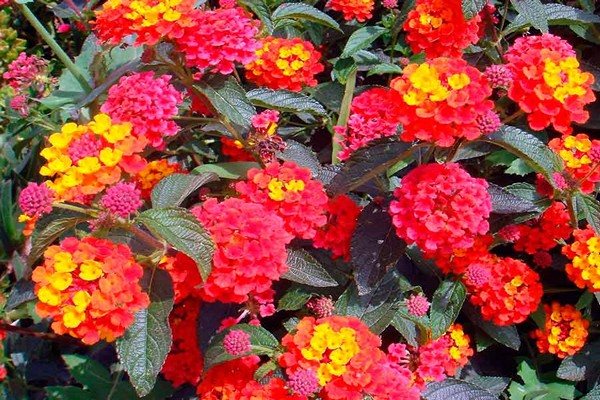

Humidity
In fact, Lantana is not very demanding on room humidity. This flower can grow both in a greenhouse and in a constantly ventilated room. Nevertheless, as experts say, spraying is still a very useful procedure that should not be neglected, since a constantly moisturized plant will be much more beautiful and brighter.
Watering Lantana
Watering this flower is a fairly standard procedure, and it does not imply any unusual approaches or techniques. It is enough just to water the flower regularly and abundantly.Moreover, in summer or spring, of course, it is watered in a much larger volume than, for example, in cold winter, when Lantana is already at rest. However, it should be remembered that rushing to extremes when watering absolutely any plant is a huge mistake. If you overdrive it, it will be bad. If you overmoisten it, it will be bad. You should stick to the golden mean.
Fertilizer
Lantana is a plant for which feeding is, although not a necessary procedure, but still very desirable. By feeding Lantana at least twice during the growing season, you will get much more beautiful and bright inflorescences from it, as well as, of course, more active growth. It is most often used as a fertilizer for this unusual flower. Complex mineral fertilizer. However, the dosage, in comparison with that described on the package, must be reduced by at least half. In winter, feeding is, of course, not necessary.
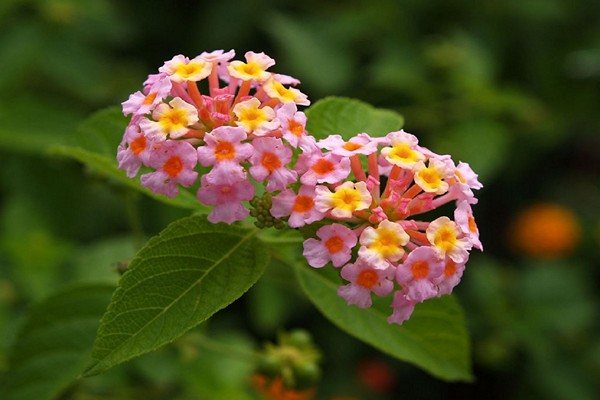

Lantana transplant
This unpretentious flower is transplanted no more than once a year, since there is simply no need for this procedure to be carried out more often. This is done when the dormant period of the flower comes to an end, but still, nevertheless, has not ended. It is very important when transplanting, by the way, to remember about high-quality drainage, which is simply necessary to provide Lantana. Otherwise, there is a chance that the water will stagnate in the soil for too long and adversely affect the roots of Lantana. On the other hand, Lantana may not be transplanted at all. Many advanced gardeners instead cut the longest cuttings and shoots from it and simply root them, thus killing two birds with one stone.
Pruning
Lantana is a plant that blooms exclusively on its young shoots, which appeared this year. Therefore, before the flower wakes up from winter sleep, it is advisable to get rid of all old or diseased branches. All others are not removed, but shortened to one third of their original length. This is done in the last weeks of winter, but it is imperative to guess the timing so that the plant is still "resting" by this time.
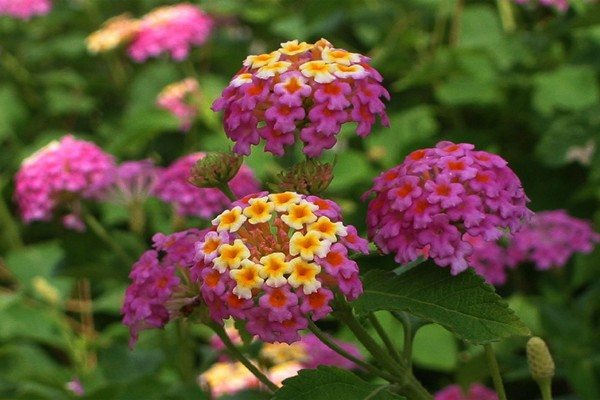

Growing conditions
The plant, although light-loving, put up with a lacy shadow. Lantana can be placed on the south, south-east and south-west balconies during the summer.
Finding the right lantana pot is important. It is good if it is of light colors, in such a container, the roots of the plant will not overheat. The ceramic pot will also be comfortable for the plant due to its breathability. However, in a ceramic container, lanthanum will have to be watered more often.
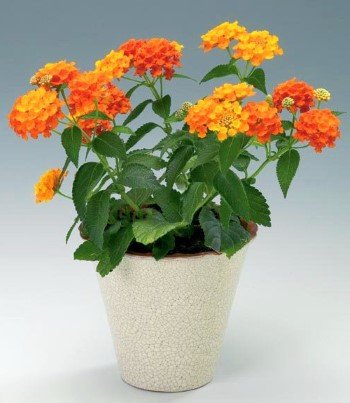

A light pot is preferable
Summer comfortable temperature for lantana is +20 +25 degrees, the flower loves moist air, and needs spraying. For the winter, plants are brought into the room, and create comfortable conditions for a dormant period. This is an air temperature not higher than +12, dim lighting, poor watering, but spraying does not stop. Too dry indoor air weakens the plant. With the onset of spring, lantana branches are cut by a third, thereby stimulating the growth of new shoots and tillering of the plant. The pruned twigs can be used to propagate the flower.
A soil mixture for lantana is prepared by mixing turf, sand and humus in equal parts. Up to 30% of high moor peat is added to this mixture, as it contributes to the moisture holding capacity of the soil.
How to propagate Lantana?
For the reproduction of this flower, several methods are actively used, of which, however, seed and cuttings can be distinguished, as the most effective. In addition, they are the simplest and most convenient to implement, so even a beginner can cope with their implementation.
If your choice fell on Lantana seeds, then you can buy them in almost any store or market.Moreover, they are present in a huge variety of varieties and species, which once again tells us how popular and interesting the Lantana genus is. The best month to plant seeds is February. This is done, of course, not in the ground, but in special containers, where the seedlings will feel comfortable and can begin to develop and germinate in the near future. For the first time, while the seedlings have not yet begun to break through the ground, you can cover the container with special glass or film. This will create an artificial greenhouse effect in the growing container. However, after the seedlings begin to germinate, the glass is nevertheless removed and the newly appeared sprouts are allowed to rest a little from the heat and moisture. This means that they will need to be kept cool for some time. In a few weeks, when the seedlings turn into real seedlings, having fully grown stronger, they can be dived into separate pots.
If your choice turned out to be petioles, and not seeds, then you need to follow this instruction: the petioles must be cut off not young, but already lignified. It is desirable that they have a so-called "heel". The length of the cut cutting should be at least ten centimeters. Otherwise, there is a great chance that it will not take root. In order for rooting to take place faster and better, you can add a little peat and sand to the pot. Their proportions must be equal. After the cuttings are sufficiently strong, the container with them will need to be moved to a cooler place. Although, we ran a little ahead, because it is necessary to mention that very important procedures must be carried out before landing. The most important of these is disinfection. The fact is that the seed is completely protected from external penetration of bacteria, fungi and viruses. But the handle has an open cut, which is a real open gate, hospitably inviting bacilli to enter. However, let's get back to growing seedlings. After the cuttings look like real young seedlings, they can be planted in their own pots, like full-fledged Lantanas.
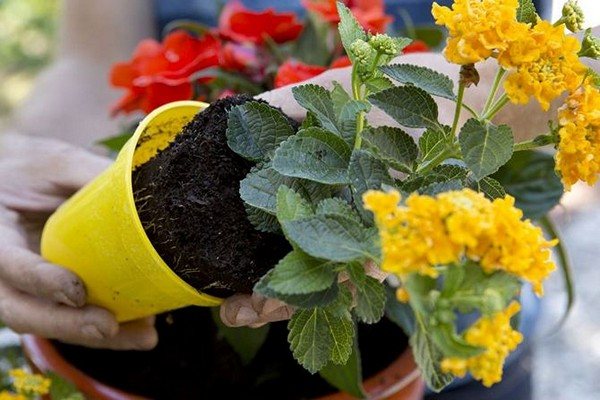

Reproduction methods
Lantana reproduces in two ways.
Cuttings
New cuttings are planted in the fall. For this, only young seedlings are used, not covered with a coarse crust (like an adult bush). Lantana should be rooted in moist and nutritious soil or in water.
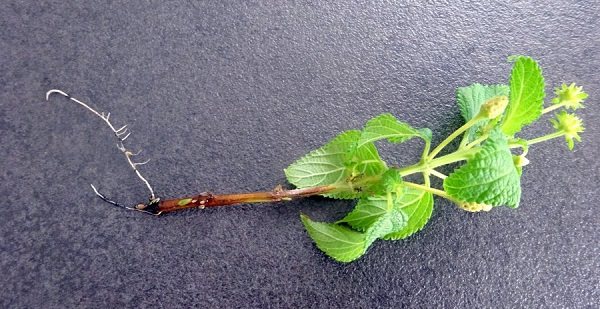

Seeds
Seed propagation requires planting in the ground at the end of the winter period. It is best to take nutritious and loose soil. Put the seeds in a container and store them in a brightly lit place, the temperature should be 20..22 degrees. The first shoots will appear in two weeks. You need to plant young seedlings after they grow up to 10 cm.
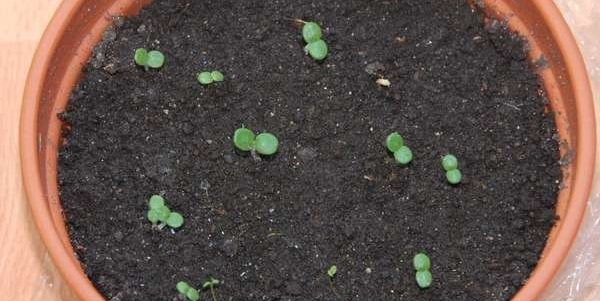

Pests
Of course, there is no plant that no insect wants to eat. And, of course, Lantana was no exception. However, it should be noted that with good flower care, problems usually do not arise. So following the instructions is already an excellent prophylaxis against pests.
Nevertheless, if they are still wound up, and you can find both spider mites and the well-known aphids, you need to act immediately. First of all, the usual processing of the flower is carried out with a not too concentrated soap solution. If this does not help, then you will have to resort to insecticides. However, they are very harmful in large quantities, so be careful.
Types and varieties of Lantana
As already mentioned, the genus Lanthanum unites more than one hundred and fifty species. However, we would like to highlight only two of them, one of which should be known to everyone who wants to start this plant, and the second of which will be very interesting to collectors.
Lantana camara
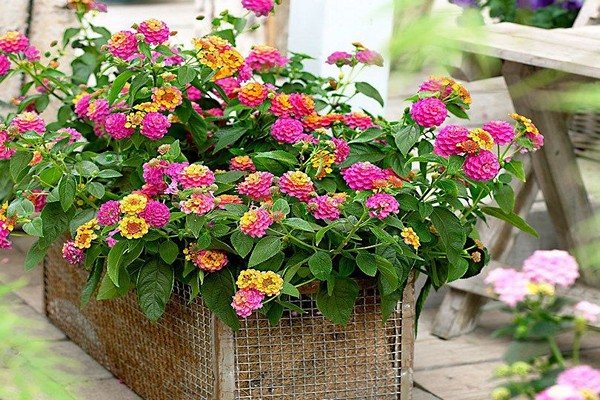

We have already mentioned it and said that this particular type of Lantana is the most popular and desirable among all gardeners and florists.Its stems, unlike almost all other Lanthanas, curl, which, of course, makes the flower only more beautiful. However, the stem is not smooth, and there are needles on it, and therefore, when working with Lantana Camara, you need to be careful. The leaves, by the way, are also distinguished by their decorative effect. On the one hand, namely, on the bottom, they are covered with small villi, but on the upper side, the leaves are absolutely smooth. The inflorescences of this species themselves have a distinctive appearance and are somewhat similar to small bouquets. Since not all flowers change their color at the same time, these small bouquets look very motley and colorful. Speaking of flowering, it should be noted that the first buds begin to appear in May, and, as described above, they have a rich yellow hue. Over time, it gradually turns to red, becoming pink and orange along the way. Lantana camara blooms right up to the very end of summer.
Lantana varieties camara
Golden cloud - This variety is distinguished by its bell-shaped buds, which at the very beginning of flowering have an incredibly bright yellow tint.
Cocktail - this variety has significantly smaller buds than the previous one, however, the variety of flowers, on the contrary, is greater, as the name hints at.
Niada - this variety, unlike all the others, has snow-white buds, which turn yellow from the inside over time, acquiring a creamy shade.
Pink queen - inflorescences of this variety are somewhat reminiscent of one large flower, and small flowers are its petals. Initially, their shade is yellow, and over time it turns into pink (from the outer flowers to the central ones), creating the illusion of a single whole.
Lantana Montevideo
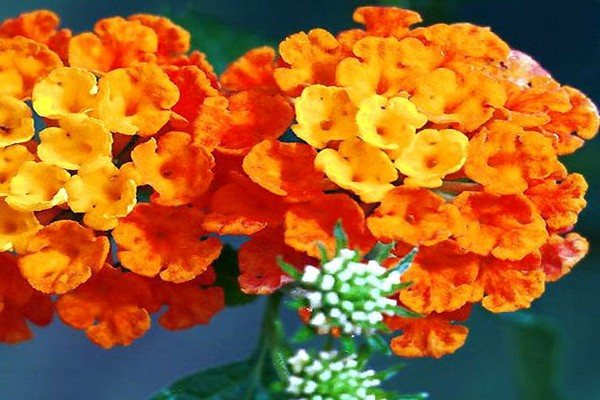

Compared to all other species, this one is very rare, and therefore it just needs to be mentioned as an incredible find for collectors. The leaves of this species are much smaller than those of others, which further emphasizes the splendor of its flowers. Throughout almost the entire flowering, they remain purple-pink, while having yellow-white centers. However, this species is especially appreciated for its long flowering, which begins in June and ends only in October.
Care
Caring for lantana, as for all indoor plants, consists in proper watering, timely feeding, pruning.
Watering and feeding
In watering, it is important to observe the measure - both waterlogging and drying out are harmful. In summer, lantana should be watered every 3-5 days. The soil in the pot should be moist at all times.
In winter, watering is reduced to 1 time in 1.5–2 weeks. The top layer of the earth should dry out a little between waterings.
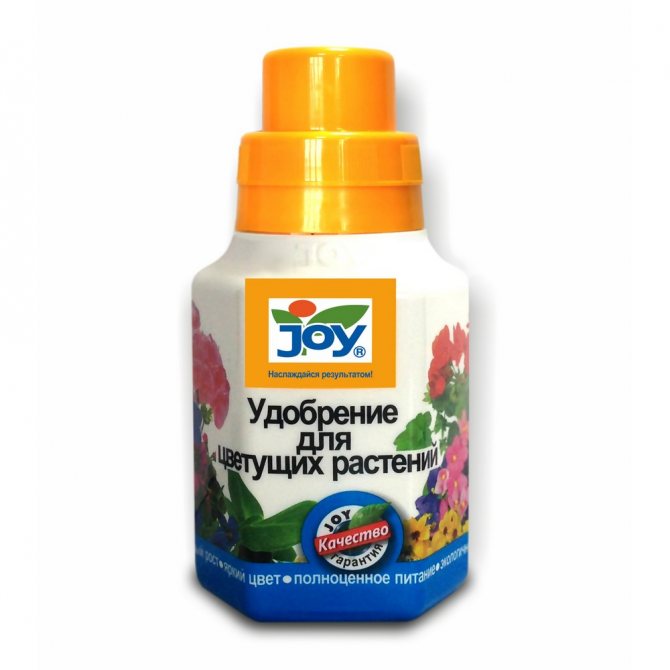

Lantana is fed with a special fertilizer for flowering indoor plants
During growth and flowering (spring - summer), lantana is fed once every 2 weeks with a special fertilizer for flowering plants. The soil should be well moistened during feeding. You can also use organic matter (alternating with mineral compositions) - for example, mullein infusion (1:10). When buds appear, 30 g of superphosphate (previously dissolved in hot water) is added to the fertilizer per 10 liters of water.
Fertilizing with a high nitrogen content will cause the plant to thrive without blooming.
Flowering period
Lantana bloom begins in May and lasts for several months. Beautiful globular inflorescences attract attention. Flowers of one inflorescence can be colored in different shades.
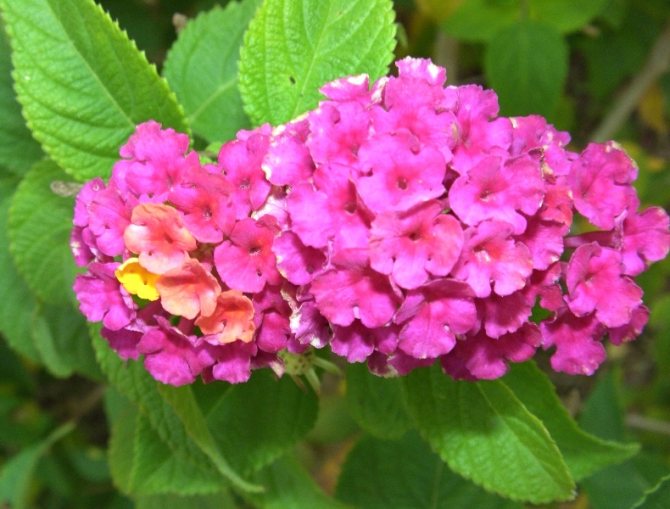

Lantana bloom begins in May, lasts all summer
Faded flowers are pruned, preventing the formation of fruits, which weaken flowering.
Dormant period
Providing a dormant period for lanthanum is the key to good flowering in the next season. The temperature of the room where lantana overwinters should be in the range of 8-10 ° C. Watering is reduced, feeding is stopped.If the lantana leaves some of the foliage at the same time, don't worry. The dormant period lasts from November to February.
Pruning
To form a beautiful neat crown, the plant is pruned in the spring, after the end of the dormant period. Pruning also stimulates flowering.
Shoots are cut by about a third with sharp disinfected scissors. After that, new branches begin to actively form.
Depending on the wishes of the owner, lantana can become a bush, a standard tree or an ampelous plant.
Formation of lantana on the trunk
- Choose an upright young lantana with a strong stem.
- Remove all side shoots, leaving only the top.
- Set up a support (such as a bamboo or wooden peg) and tie the plant to it. This is to keep the trunk straight.
- When the lantana grows to the correct height, the top of the stem should be cut off. The support can be changed to an even higher one.
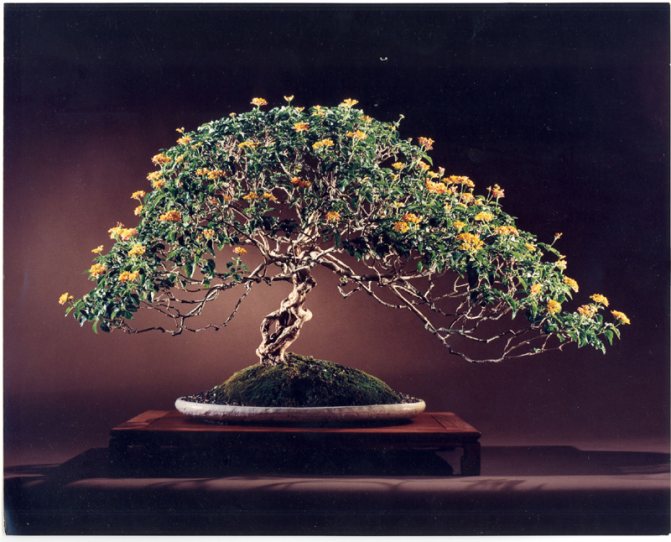

As a result of pruning from lantana, you can get a standard tree
Table: problems and solutions
| Problem | Cause | What to do |
| Leaves are shrinking | Little light | Move the plant to a more illuminated place, provide direct sunlight for several hours a day. |
| The stems are pulled out | ||
| The ends of the leaves dry up | Insufficient moisture in the soil, dry air | Water and spray more often. |
| The tops of the shoots are curled | ||
| Does not bloom | Cool wintering was not provided | In the next period of rest, put in a cool room (8–10 ° C), reduce watering. |
| Little light | Provide better lighting. | |
| Leaves turn pale, shoots stretch out | Lack of nutrients in the soil | Adjust the feeding mode. |
| Flowers fall | Low temperature | Increase the room temperature. |
| Dry air, lack of watering | Water and spray more often. |

